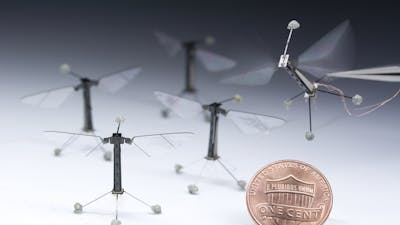
Inspired by the biology of a bee, researchers at the Wyss Institute are developing RoboBees, manmade systems that could perform myriad roles in agriculture or disaster relief. A RoboBee measures about half the size of a paper clip, weighs less that one-tenth of a gram, and flies using “artificial muscles” compromised of materials that contract when a voltage is applied. Additional modifications allow some models of RoboBee to transition from swimming underwater to flying, as well as “perch” on surfaces using static electricity.
The masterminding of the RoboBee was motivated by the idea to develop autonomous micro-aerial vehicles capable of self-contained, self-directed flight and of achieving coordinated behavior in large groups. To that end, the RoboBee development is broadly divided into three main components: the Body, Brain, and Colony. Body development consists of constructing robotic insects able to fly on their own with the help of a compact and seamlessly integrated power source; brain development is concerned with “smart” sensors and control electronics that mimic the eyes and antennae of a bee, and can sense and respond dynamically to the environment; the Colony’s focus is about coordinating the behavior of many independent robots so they act as an effective unit.
It’s really only because of this lab’s recent breakthroughs in manufacturing, materials, and design that we have even been able to try this. And it just worked, spectacularly well.

To construct RoboBees, researchers at the Wyss Institute have developed innovative manufacturing methods, so-called Pop-Up microelectromechanical (MEMs) technologies (please also see the Pop-Up MEMS technology page) that have already greatly expanded the boundaries of current robotics design and engineering.
Significant development still needs to be achieved for the RoboBee to operate outside of the lab. However, the underlying Pop-Up MEMs is being used for Manufacturing Mini Surgical Robots.
